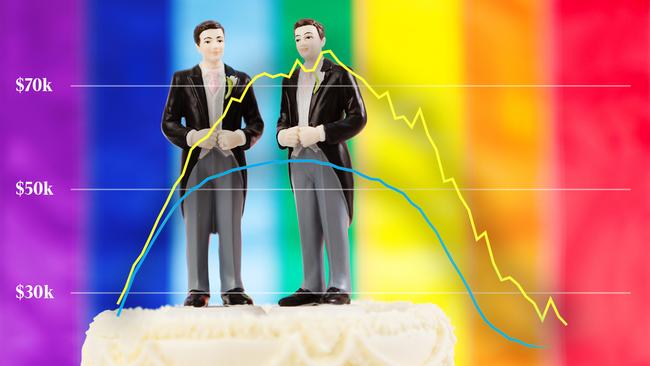
Why would anyone refer to this as the pink dollar? This is an unnecessary and unfitting metaphor. It clearly needs to be called the “rainbow dollar”. A much better term. Let’s hope it sticks.
How can we get reliable data on the rainbow dollar? After all, we are not asked about our sexual orientation in the census. However, we do provide information about the relationship between different household members.
When the two adults living in a household are both male and the relationship between them is listed as “husband or wife” or as “de facto partner” we can conclude that the two men are gay. This line of reasoning is referred to as the “same-sex indicator”.
We can extract data from the census on the demographics of the rainbow subgroup that is in a permanent relationship and lives in the same household. To compare like for like, we will benchmark this group with members of straight couples.
First, let’s analyse the income profile of individuals who are in a permanent relationship by sexual orientation. The line chart even forms a lovely rainbow shape.
Right up to the mid-20s, same-sex and straight folks have almost identical incomes. This is when couples start having kids and the household loses an income for a while. After a period of child rearing the primary carer, most commonly the mother, returns to work (often with reduced hours).
While away from work the primary carer missed out on promotions, which means their income is now lower compared to workers that didn’t take parental leave (most commonly men).
In a same-sex couple, it is much less common that one of the partners takes time off to become a primary carer. Sure, plenty of same-sex couples are also parents but at a much lower rate than straight couples. While 45 per cent of straight couples have at least one dependent child, only 13 per cent of same-sex couples have kids to look after. Within male same-sex couples, that figure is only 4 per cent, whereas 23 per cent of female same-sex couples care for a dependent child.
The result is a growing difference of the two income curves. A 46-year-old member of a same-sex couple has an annual income of $78,000, which is $22,000 (or 39 per cent) more than their straight counterpart earns.
Throughout an entire career a same-sex couple out-earns a straight couple by about 30 per cent.
Same-sex couples earn more money and have fewer child-related costs — no additional mouths to feed, no school fees, no pressing need for additional bedrooms in the home.
Their average educational attainment is also higher (not having had childcare-related responsibilities arguably frees up time for further study), with 45 per cent of partners in a same-sex relationship holding a BA degree or higher compared to 29 per cent among straight partners.
This leads to different behaviour on the job market.
The Australian Bureau of Statistic differentiates between 1300 jobs. These jobs are divided into five skill levels indicating how much formal qualifications you need to acquire before being allowed to work in that profession.
Partners in a same-sex couple are much more likely to work in the two highest and best-remunerated skill levels (63 per cent and 53 per cent respectively).
Highly skilled jobs like to cluster in the office towers of our capital cities. It is therefore no surprise to see the rainbow dollar being much more inclined to be invested in real estate near the central business districts of our largest cities.
Only 5 per cent of all straight couples live within a 5km radius of the CBD of our capital cities. For same-sex couples, that figure rises to 22 per cent.
We learned earlier that female same-sex couples are more inclined to have children compared to same-sex male couples. This explains why male same-sex couples are much more likely to move to the city centre (31 per cent) than female same-sex couples (14 per cent), who more closely mirror the housing patterns of straight couples.
The above data culminates in same-sex couples favouring fewer bedrooms in their home, being less likely to live in a separate house (56 per cent compared to 82 per cent) and instead opting for semi-detached dwellings or apartments (44 per cent compared to 18 per cent).
Since the same-sex dwelling is also much more likely a rented property (39 per cent compared to 23 per cent), a smaller share of the rainbow dollar is used to finance housing needs.
You could argue that, since a childless couple doesn’t feel the same need to invest in a home for the children’s sake, the average same-sex couple is much less driven by the Australian dream of home ownership.
If there are no children to look after, you can spend your money on yourself without constantly feeling you are robbing your children’s (and grandchildren’s) future.
This means same-sex couples have more money available to spend on the luxuries of life.
Same-sex couples buy nicer and fancier furniture for the inner-city apartment, frequent the more expensive restaurants and shops of the inner city, and buy more expensive products and services.
That doesn’t mean same-sex couples aren’t civic-minded. They volunteer at the same rate as their straight counterparts.
The tendency of the rainbow dollar to flow to the higher end of the consumer market isn’t because being same-sex-attracted makes you want to spend lavishly.
Rather, the largest share of same-sex couples belongs permanently to the DINKs (double income no kids) cohort.
This cohort, while missing out on the joy of parenthood, has no offspring to share their wealth with and plan for, doesn’t experience child-related career breaks and has a higher disposable income.
Chasing the rainbow dollar is highly lucrative and no marketer in their right mind would want to miss out on that cohort.
Simon Kuestenmacher is co-founder and director of research at The Demographics Group




Let’s explore a market segment that developers and marketers might want to tap into. Let’s look at one of the wealthiest, most lucrative and most fun market segments. Economists speak of the “pink dollar” when analysing the purchasing power of the LGBT community.